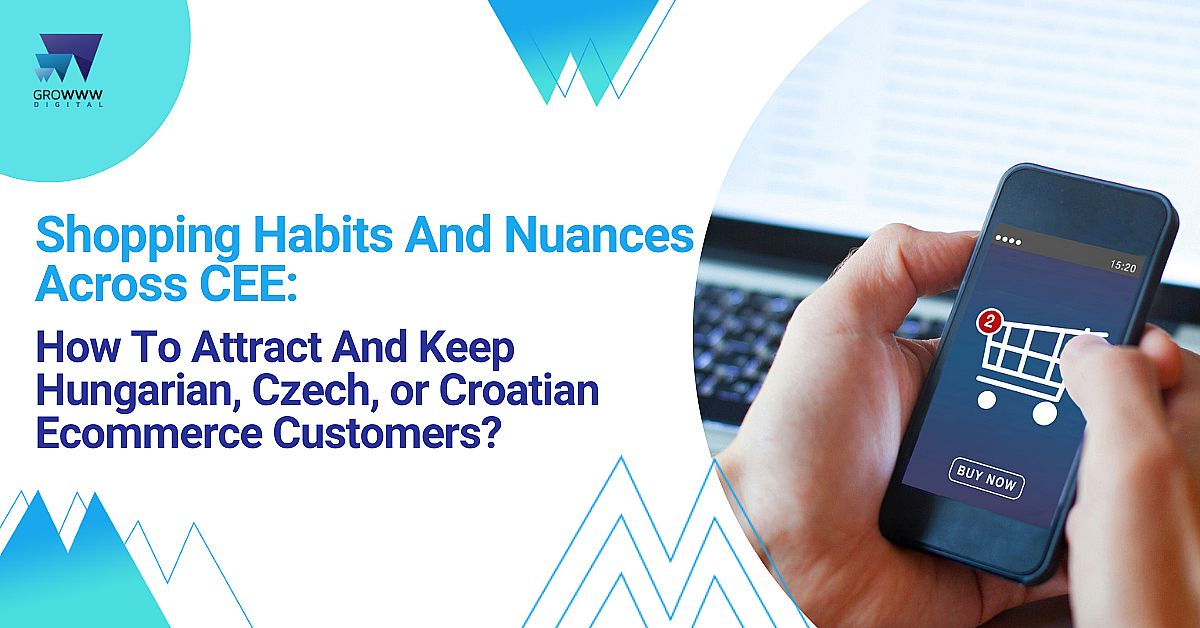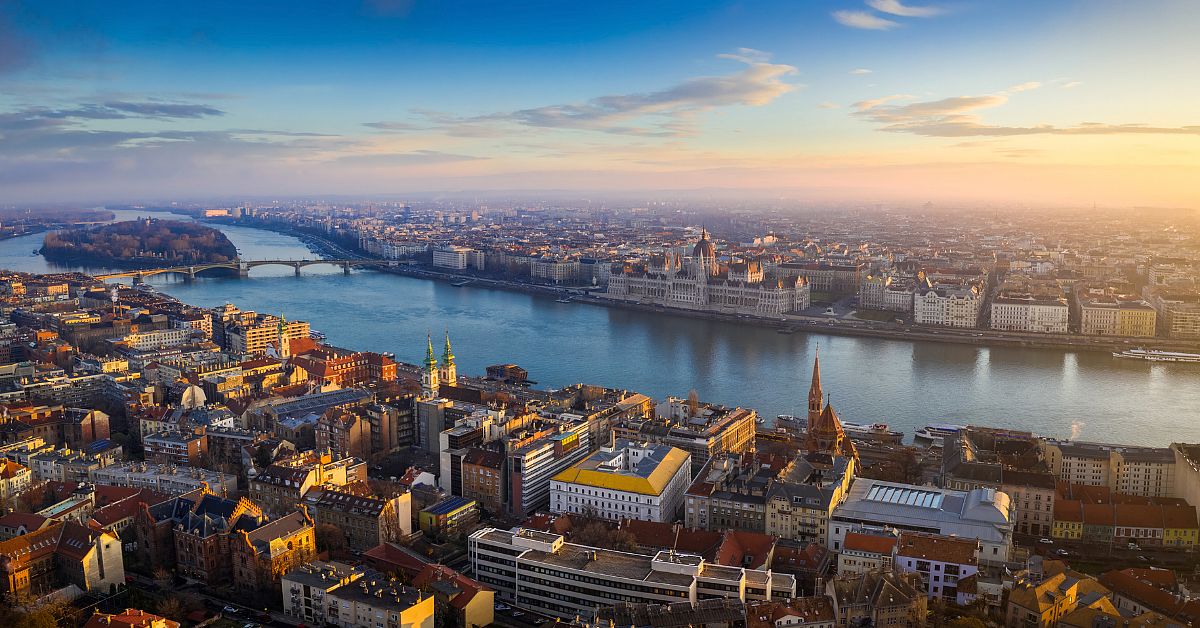
Shopping Habits And Nuances Across CEE: How To Attract And Keep Hungarian, Czech, or Croatian Ecommerce Customers?
Shopping Habits And Nuances Across CEE: How To Attract And Keep Hungarian, Czech, or Croatian Ecommerce Customers?
From Slovakia through Romania all the way down to Slovenia, who shops the most consciously, who loves to hunt for bargains, and who’s just too cool for school? Find out the most eye-striking as well as the most subtle online shopping habits and nuances across Central Europe.
Want to expand in the region? Download Your Free Ultimate CEE Ecommerce Export Guide!
75 pages packed with all you need to know as an ecommerce business before you expand to Czechia, Slovakia, Hungary, Romania, Croatia and Slovenia.
Hungary: patriotism, deal-hunting, and search for showrooms
Hungary is a country of patriots. Not only are they proud of their cuisine (paprikash, anyone?), their heritage, and language with double the alphabet, they proudly buy from fellow Hungarians.
Lucky for ecommerce exporters, they also increasingly shop abroad. There are over 2,000 Czech online stores (and counting!) already on the market as a testament. But make no mistake: when in Rome, do as Romans do. Localisation is an absolute key.
How to inspire customers to choose you? Besides speaking their lingo, know this: Hungarians like the best deals, and 8 out of 10 customers won’t hesitate to check more options before clicking “pay”, basing their decisions largely on price.

A typical Hungarian is generally very happy to hear words such as promotion, discount, or free (shipping). They also want the 21st century ecommerce experience. Same or next-day delivery, personalised offers, a 30-day return option, and 7-day customer care go a long way.
Price is a big deciding factor, but so are reviews. Testimonials to your products and customer experience can make you or break you on the Hungarian market. Especially when you don’t (yet) have a showroom, a collection point, or any other sign of physical presence.
Hungarians are indeed very particular when it comes to showrooms: for many, they are a testament to the company’s trustworthiness (and existence). It is especially true outside the Budapest area, where trust in online shopping and online payments is growing at a slower pace. In fact, setting up a local company makes life a lot easier for a foreign online store.
Czechia: Hard-to-please crowd with high trust in ecommerce
With the highest number of online stores per capita in the world, Czech online shoppers have incredibly high standards for delivery and customer service.
One prevalent tendency is looking for the best price: Czechs search for products on comparison prices or use Google Shopping to find inspiration, compare options, and yes, also look for the best deal.
But price hunting is not typically the goal in and of itself, quality of delivery is crucial: fast, reliable, and flexible. Most of the country is used to waiting 2-3 days to get their orders delivered (shorter when it comes to groceries), while customers in Prague consider the same-day, or at least next-day delivery a standard.
This also means offering a huge variety of pick-up and delivery options. When locals don’t find several pick-up places with flexible opening hours close to their home (or work), they likely shop elsewhere.
High expectations apply to other delivery aspects, from same-day or next-day delivery to the quality of packaging to a series of automated emails about the current state of their order.

This is a norm when it comes to B2C communication. Czechs automatically find a store matching up to these norms trustworthy, without needing to google the actual premises like showroom, office, or even a phone number. They expect both the shop and the courier to keep them up to date until the package lands safely in their hands.
Apart from the speed, having products in stock is another important variable. Similar to neighbouring Slovakia, 30% of customers would rather leave the site if they didn’t see their product in stock or available in the next couple of days.
Want to expand in the region? Download Your Free Ultimate CEE Ecommerce Export Guide!
75 pages packed with all you need to know as an ecommerce business before you expand to Czechia, Slovakia, Hungary, Romania, Croatia and Slovenia.
Romania: Mobile shopping generation who loves Black Friday
A country where millennials aged 25-35 took over online shopping, mobile-first penetration is the highest across the globe (76%) and Black Friday comes multiple times a year, builds a solid ground for experienced players to reap the rewards of what they’ve learnt so far.
Romania is such an interesting country when it comes to acquiring customers. Their shopping mentality is a unique blend of demand for generic products to be fast and affordable.
But there’s also an insatiable appetite for a variety of fresh choices, small luxuries, and even high-end products. Cool, well-renowned, or love brands are equivalent to status.
Unlike the rest of CEE, where electronics is traditionally the number one segment, Romania’s largest ecommerce industry is fashion. Clothes, footwear, and accessories account for 40% of the online retail revenue.
“These generations are known to be tech-savvy, service-oriented, and speed driven. A large part of ecommerce is backed by this generation that prefers to shop online,” the CBRE report states.
Regardless of how enchanted by the possibilities presented to them by the social media and online shopping they are, deeper and more personal contact is crucial to gaining a Romanian customer.
Trust is built with locals when they know you have a showroom in their city or country, where they can see the product (even if they end up having it delivered at home).
If you don’t have a store just yet, show your premises on a localised (mobile-first!) website and offer native-speaking customer support together with a local phone number.
“In some cases, 50% of the orders come via phone calls,” László Szabó of Growww Digital says.
Product certificates or licences are recommended. Romanians have historically been flooded with fakes from Turkey or Italy being sold as the real deal, so meet them halfway.
Slovakia: Regular shoppers want an A+ customer experience
Most Slovaks shop online repeatedly – they trust online stores and up to 86% of the population considers online shopping a norm.
Price is important but equally crucial is having the product in stock. Promptly delivered product at the best price with an A+ customer experience gets them to rave about you all over the social media and come back for more.
Slovakia is yet another mobile-first country. Communications infrastructure has undergone a major modernisation, connecting (nearly) every village to the internet. With seven out of ten Slovaks owning a smartphone, two-thirds of online purchases are done via phone.
A positive customer experience usually results in a repeated purchase, especially in segments such as clothing.

According to DPD’s 2019 research, 83% of respondents seek reviews before buying. Half of them can be thrown off by a negative review on social media.
Two-thirds of online shoppers prefer to choose environmentally-friendly products rather than their “traditional” counterparts. One-third prefer buying in stores that offer free shipping.
Want to expand in the region? Download Your Free Ultimate CEE Ecommerce Export Guide!
75 pages packed with all you need to know as an ecommerce business before you expand to Czechia, Slovakia, Hungary, Romania, Croatia and Slovenia.
Slovenia: A shopping mentality close to Western countries
Slovenia is “a little Scandinavia” in the wider CEE region. Locals have strong purchasing power, and – like Spiderman – they use it with great responsibility.
They browse and calculate because they believe the shopping experience should fit their lifestyles: the store’s UX and customer care, brand, mission, stance on environmentalism, as well as practicalities such as price and fast delivery matter to them.
Out of the 2m population, 86% are internet users, and about 60% shop online. Slovenians like to shop in local-owned online stores. Based on Ceneje.si and Valicon research, 47% prefer to buy from Slovenian-owned online businesses.
When it comes to electronics, home and decor, DIY, or hobby, national players have a very strong position. Slovenes are also fairly used to buying from abroad brands, from Amazon to service-based platforms such as Airbnb: 18% shop cross-border regularly, mostly in Germany, Italy, Austria, and China.
Another interesting fact about Slovenia’s population is how equally it is distributed: 55.3% of inhabitants live in urban areas and 44.7% in rural parts of the country – numbers that come to play when putting together the logistic/delivery puzzle or even in PPC strategising.
Contrary to other Balkan countries, a 5-day delivery is not an option for Slovenes. The stores that are thriving on the market made it their mission to work on smooth logistics.
Croatia: Seeking trends and comparing prices obsessively
Up to 70% of the country’s 4m population shop online, according to Eurostat. Statistically, an online shopper in Croatia is a frequent (monthly) one and interestingly, new online shoppers are growing the fastest per capita, compared to other EU countries. More than a half buy once a month (53%), 16% once a week, and 3% daily.
Locals love to follow trends and innovations from fashion to phones. But the general population does not yet have the economic power to capitalize on all of their wishes. Hence, price is the most significant purchasing determinant, making price comparison websites popular tools amongst Croats.
This does nevertheless go hand in hand with increasing confidence in online shopping and increasing sums spent online. After years of recession, Croatia has finally recovered, and its citizens are increasing their household spending.
Where do Croats typically shop? Their support of local brands, culture, and entrepreneurship – something Croats take pride in – shows in retail rather than in ecommerce. Online, 22% shop exclusively in domestic online stores (often, those who do are above 50 yo), 20% make 90% of their purchases abroad, and 33% mix the two.
Apart from the above-mentioned marketplaces, when shopping abroad, Croats chose Germany most often (followed by Italy, Slovenia, Austria, and Hungary).
Mobile shopping is estimated to be the number one source of purchasing power in the next five years, as 97% of young people access the internet via smartphone. For online stores, this means focusing on mobile-first websites as well as creating their own apps.
Do you need a partner to help you expand abroad? Reach out!
Fill in the form or feel free to contact László Szabó, co-founder and Head of Growth at Growww Digital, at szabo@growwwdigital.com or +36 30 537 7051
Want to expand in the region? Download Your Free Ultimate CEE Ecommerce Export Guide!
75 pages packed with all you need to know as an ecommerce business before you expand to Czechia, Slovakia, Hungary, Romania, Croatia and Slovenia.
